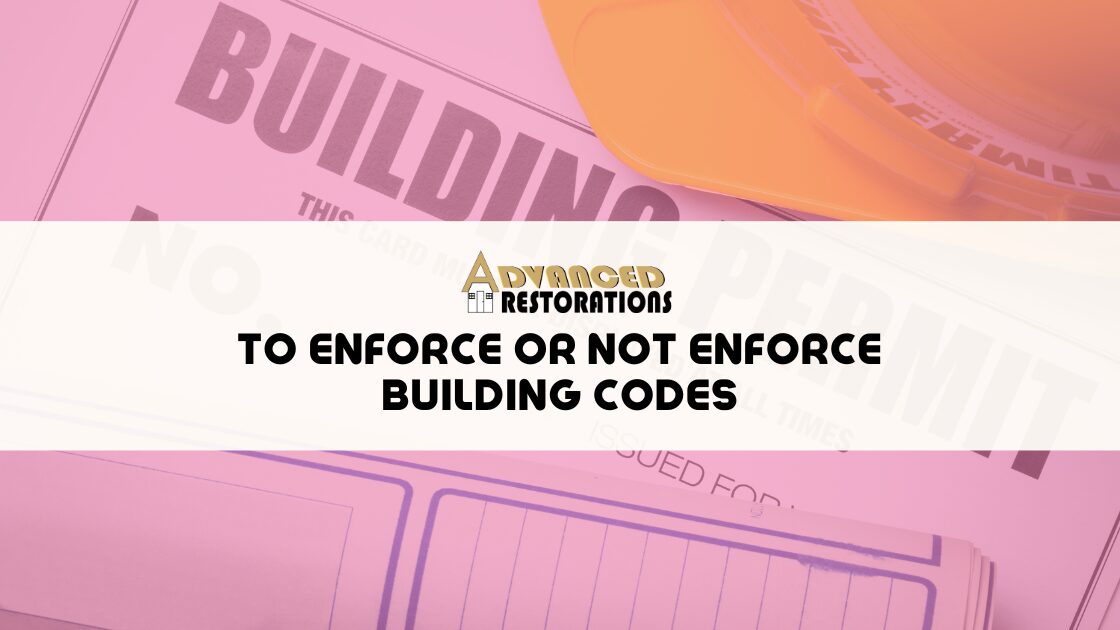
Outside of extremely rural areas, many cities and counties choose to adopt sets of building codes to be applied in their given jurisdiction. In most cases, this involves the use of the International Residential Code and the largest variation will be upon which edition has been adopted – the IRC is typically updated about every three years so a person could see editions from 2003 to 2018 adopted locally.
To backtrack a bit, the International Residential Code is put together by the International Code Council – intended to be guidelines for the bare minimum of requirement when performing residential construction. From the 2018 edition, we have section R101.3:
“Intent – The purpose of this code is to establish minimum requirements to safeguard the public safety, health and general welfare through affordability, structural strength, means of egress facilities, stability, sanitation, light and ventilation, energy conservation and safety to life and property from fire and other hazards attributed to the built environment, and to provide safety to fire fighters and emergency responders during emergency operations.”
In most cases, the code itself will also refer you directly to manufacturer’s specifications as many products have installation requirements that are above and beyond the basic requirements of the IRC. At Advanced Restorations, we pride ourselves on keeping up to date with any changes related to code adoption in the areas we are performing repairs.
One thing that comes up often in our field is the question of – does the local city or county actually enforce the code they’ve adopted? At face value, it’s a bit of an odd question – why would a governmental organization go through the process of adopting a standard and then not require it to be used?
Some municipalities, when called to ask about enforcement, may indicate they don’t have the manpower to do so. In some areas, you may get an entirely different response dependent upon the person you happen to get on the phone that day. It can be frustrating for a homeowner wanting to confirm their project will be completed correctly if they run into conflicting answers such as this.
Thankfully, the ICC had the foresight to understand this scenario may come up from time to time and they included guidance within the IRC to help resolve these issues. First, any group adopting an edition of IRC has the option to adopt amendments to the code when first putting it into place. One area that will often involve amendments during code adoption is table R301.2 – this table accounts for region/geographic-specific temperature information and how that impacts several additional codes.
So, lacking a specific amendment during adoption tells us that any code active in that edition of IRC would be a part of the code requirement for that area.
”But I called my local building department and they said such and such is not required?”
This is a great question and one we unfortunately run into all too often. We must remember that members of a given building department may not have started out their career in the construction industry or had any plans to be involved in it in any way. In our experience, many of those snap judgements made in response to homeowner inquiries are done in error simply due to a lack of understanding of the currently adopted code. Thankfully again, the ICC planned for scenarios like this.
The first chapter of any IRC edition is going to lay out the scope of the code and administration of the code itself. This chapter covers what scenarios would be applicable to the requirements of the code, the intent of the code, and it also covers the duties and powers of a building official for a jurisdiction that adopts the code.
Section R104.1 reads as follows:
“The building official is hereby authorized and directed to enforce the provisions of this code. The building official shall have the authority to render interpretations of this code and to adopt policies and procedures in order to clarify the application of its provisions. Such interpretations, policies and procedures shall be in compliance with the intent and purpose of this code. Such policies and procedures shall not have the effect of waiving requirements specifically provided for in this code.”
Whew, that’s quite a bit of information to get through but what does it mean? This means that if the building inspector for your jurisdiction indicates over the phone that a portion of the code “isn’t required”, that would not hold true unless there was a specific amendment that ruled it out during adoption of the code. The building official can offer interpretation as to whether a method of repair met the code requirements, but they are not legally able to pick and choose which portions of the code are required. In fact, one could argue that in accepting the building official position with an adopted code in place, they’ve acknowledged that they are legally required to enforce the code in total.
With IRC setting out to establish the bare minimum of construction standards, it’s not unreasonable for a homeowner or their contractor to want their repairs completed to that level. As a homeowner, it may require prodding and pushing but the building department in your municipality needs to be held accountable for the code that has been adopted. As a contractor, we also need to be accountable to complete repairs to those standards – if not going above and beyond – to ensure homeowners are left with a property that is not only aesthetically pleasing but also meets the safety requirements of the established code. Call Advanced Restorations today at (417) 229-0667 to schedule time for one of our knowledgeable Field Supervisors to review your property! Our staff is well versed in code requirements, no matter where your home is located!
